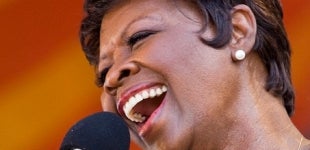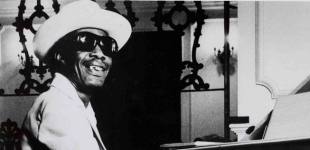Malcolm “Dr. John” Rebennack
1940
1940
By Ben Sandmel
Mac Rebennack, better known by his stage name, Dr. John, is an acclaimed New Orleans R&B pianist, guitarist, singer, songwriter, and producer. He is equally renowned as a flamboyant cultural icon who speaks in a self-invented quasi-beatnik/New Orleans language, based on the concept of “trickonology,” and summed up in the statement “Life is always gonna be off the chain, and you can’t never hang no jacket on it.”
Born in 1940, Rebennack was exposed to R&B and blues at an early age in his father’s record and musical-equipment repair shop. At age seven, Rebennack took up the guitar and started taking lessons from the great R&B blues guitarist Walter “Papoose” Nelson, followed by instruction from another famed New Orleans R&B guitarist, Roy Montrell; both men, at various times, were members of Fats Domino’s band. Rebennack made his first public appearances with Montrell’s aunt, a gospel singer named Sister Elizabeth Eustace.
Several years later, Rebennack started working in his own band, the Skylighters, playing cover versions of R&B hits of the day. He began performing with secular African-American R&B artists, even though such public collaboration was banned during segregation and brought the risk of police harassment. Thanks to Papoose Nelson and Roy Montrell, Rebennack got in the door as a session player at Cosimo Matassa’s J&M Studio, then the epicenter of New Orleans R&B recording. At J&M, Rebennack played on songs by such luminaries as singers Frankie Ford and Joe Tex, and pianist Professor Longhair (Roy Byrd.) He produced hits for artists including the brilliant singer Johnny Adams, wrote hits for R&B artists such as Jerry Byrne, and recorded instrumentals such as “Storm Warning” under his own name.
In 1960, Rebennack suffered a gunshot injury to his left hand that forced him to switch to the piano as his primary instrument. Fortunately, he had learned a lot about this instrument as a protégé of Professor Longhair, New Orleans’ great, idiosyncratic, Afro-Caribbean piano stylist. As the ‘60s progressed, the once-burgeoning New Orleans R&B scene began to slump, due in part to the success of “British Invasion” bands such as the Beatles. Many New Orleans musicians relocated to Los Angeles and Rebennack joined them in 1965, quickly becoming an in-demand session musician in a variety of genres. There, working with the multi-talented New Orleans expatriate Harold Battiste as his producer, Rebennack and Battiste created his alter ego: Dr. John the Night Tripper. This character was based on a nineteenth-century voodoo priest. As Dr. John, Rebennack played a unique blend of New Orleans R&B and voodoo-infused psychedelic rock. The song, “I Walk On Gilded Splinters” on his debut album “Gris-Gris,” which epitomizes this style, got considerable airplay in the then-new realm of FM rock radio, and Dr. John ascended to the global-level status that he enjoys today. Rebennack began to take this voodoo persona seriously, reflected both in music and his stage attire.
In 1972, Rebennack cut back his stage name to Dr. John and recorded a classic album of New Orleans R&B gems entitled Gumbo, featuring songs by Huey “Piano” Smith, Earl King, Sugarboy Crawford, Paul Gayten, and Professor Longhair. In 1973, he scaled the national top charts with the single “Right Place, Wrong Time,” produced by Allen Toussaint and accompanied by the Meters. Its flip side, “Such A Night,” remains a perennial favorite in New Orleans. And in 1974, again working with Allen Toussaint and Meters, Rebennack recorded the artistically brilliant album Desitively Bonnaroo which, quite curiously, made little commercial impact. The title phrase lives on, however, in the wildly successful Bonnaroo music festival, held in Tennessee, but established by a New Orleans production company.
Rebennack continued to tour and record prolifically for the next 40 years, and, at this writing, he is still performing at full strength. His body of work is diverse, including the comparatively slick albums Tango Palace and Hollywood Be Thy Name; the solo piano releases, Dr. John Plays Mac Rebennack, and The Brightest Smile In Town; tributes to Duke Ellington, and Johnny Mercer; and Trippin’ Live, with such accompanists as the late Alvin “Red” Tyler, one of new Orleans jazz and R&B’s leading saxophonists, and the late powerhouse drummer Herman Ernest. Two Grammy-winning albums have taken quite opposite approaches: 1992’s Going Back to New Orleans, which reprised the hometown theme of Gumbo, and Locked Down, from 2012, on which Rebennack played very little piano, focusing instead on his gravelly but highly effective vocals. He also won a Grammy for the 2008 album The City That Care Forgot, and was inducted into the Rock and Roll Hall of Fame in 2011.
In 1976, Rebennack performed at the farewell concert for The Band, which was filmed and released as a documentary entitled The Last Waltz. In 1979, he accompanied his mentor, Professor Longhair, on a comeback album entitled Crawfish Fiesta. Sadly, “Fess,” as he was known, died just when the album was released. Many of these and other varied career adventures are explored in his autobiography Under A Hoodoo Moon: The Life of the Nite Tripper, with Jack Rummel, published in 1994. In recent years, catastrophes such as Hurricane Katrina, and the BP oil spill of 2010, have prompted Rebennack to make many outspoken political and environmental statements. While these remarks have spawned controversy in some circles, Rebennack remains a beloved and iconic figure in New Orleans.
——–
Ben Sandmel is a New Orleans-based journalist, folklorist, drummer, and producer. Sandmel is the author of “Ernie K-Doe: The R&B Emperor of New Orleans” and “Zydeco!”, a collaborative book with photographer Rick Olivier. Sandmel has produced and played on albums including the Grammy-nominated “Deep Water” by the Cajun/country band The Hackberry Ramblers.
Recommended reading:
Berry, Jason, Foose, Jonathan, and Jones, Tad. Up From the Cradle of Jazz: New Orleans Music Since World War II. Lafayette, LA. The University of Louisiana at Lafayette Press. 2009.
Dr. John (Mac Rebennack), with Rummel, Jack, Under A Hoodoo Moon: The Life of the Nite Tripper. New York. Saint Martin’s Press, 2004.
Battiste, Harold Jr. and Celestan, Karen. unfinished blues: Memories of a New Orleans Music Man. New Orleans. The Historic New Orleans Collection. 2010.
Sandmel, Ben. Ernie K-Doe: The R&B Emperor of New Orleans. New Orleans: the Historic New Orleans Collection. 2012.

Singing is the act of producing musical sounds with the voice, and augments regular speech by the use of both…

The piano is a musical instrument played using a keyboard. It is widely used in classical and jazz music for…

A guitar is a popular musical instrument that makes sound by the playing of its (typically) six strings with the…